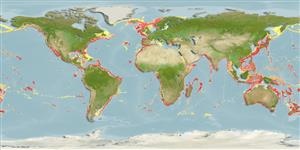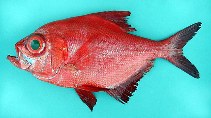Beryx decadactylus Cuvier, 1829
Alfonsino
把你的觀察加入 Fish Watcher
| Native range | All suitable habitat | Point map | Year 2050 |

|
| This map was computer-generated and has not yet been reviewed. |
| Beryx decadactylus AquaMaps Data sources: GBIF OBIS |
上傳你的 相片 和 影像
Pictures | Google 影像Beryx decadactylus
Female picture by Cambraia Duarte, P.M.N. (c)ImagDOP
Pictures | Google 影像Beryx decadactylus
Female picture by Cambraia Duarte, P.M.N. (c)ImagDOP
Portugal country information
Common names:
Alfonsim, Alfonsim-da-costa-larga, Alfonsino
Occurrence: native
Salinity: marine
Abundance: | Ref:
Importance: | Ref:
Aquaculture: | Ref:
Regulations: | Ref:
Uses: no uses
Comments:
National Checklist: Portugal
Country Information: https://www.cia.gov/library/publications/resources/the-world-factbook/geos/po.html
National Fisheries Authority:
Occurrences: Occurrences Point map
Main Ref: Maul, G.E., 1986
National Database: Portuguese Freshwater Fishes
Occurrence: native
Salinity: marine
Abundance: | Ref:
Importance: | Ref:
Aquaculture: | Ref:
Regulations: | Ref:
Uses: no uses
Comments:
National Checklist: Portugal
Country Information: https://www.cia.gov/library/publications/resources/the-world-factbook/geos/po.html
National Fisheries Authority:
Occurrences: Occurrences Point map
Main Ref: Maul, G.E., 1986
National Database: Portuguese Freshwater Fishes
Common names from other countries
分類 / Names 俗名 | 同種異名 | Catalog of Fishes(屬, 種) | ITIS | CoL | WoRMS | Cloffa
Teleostei > Beryciformes (Sawbellies) 金眼鯛目 (Sawbellies) > Berycidae (Alfonsinos) 金眼鯛科 (Alfonsinos)
Etymology: Beryx: Greek, beryx or berys = a name of a fish. Cuvier & Valenciennes (1829:221) precise that the name was used by Gesner from Varinus, but with no indication whatsoever helping identifying any species. After D'Arcy Wentworth Thompson (A glossary of Greek fishes, 1947), the name actually seems to come originally from Hesychius, but perhaps the name was not originally a fish name. Thompson compares it to meryx (ruminant), applied on skaros (Scarus), so it may have been applied on a parrot fish referring to its browsing/grazing behavior described by Aristoteles and followers.
More on author: Cuvier.
Etymology: Beryx: Greek, beryx or berys = a name of a fish. Cuvier & Valenciennes (1829:221) precise that the name was used by Gesner from Varinus, but with no indication whatsoever helping identifying any species. After D'Arcy Wentworth Thompson (A glossary of Greek fishes, 1947), the name actually seems to come originally from Hesychius, but perhaps the name was not originally a fish name. Thompson compares it to meryx (ruminant), applied on skaros (Scarus), so it may have been applied on a parrot fish referring to its browsing/grazing behavior described by Aristoteles and followers.
More on author: Cuvier.
Environment: milieu / climate zone / depth range / distribution range 生態學
海洋 深海底的; 深度上下限 110 - 1300 m (Ref. 126224), usually 200 - 800 m (Ref. 126224). 深水域; 70°N - 48°S, 180°W - 180°E
分布 國家 | FAO區域 | 生態系 | 發現紀錄 | Point map | 簡介 | Faunafri
Worldwide in temperate and tropical latitudes, except the eastern Pacific. Eastern Atlantic: Greenland, Iceland, and Norway to Western Sahara and South Africa, including western Mediterranean. Western Atlantic: south to Brazil. Also found in Argentine (Ref. 2806). Indo-Pacific: East Africa (including the Madascar Ridge and Saya de Malha Bank, Ref. 33390) to Japan, Australia, and New Zealand (Ref. 5755). The limited number of records in the western Pacific is doubtless the result of limited fishing effort below 200 m (Ref. 9833).
除了東太平洋以外,遍及全球的溫帶與熱帶的緯度。 東大西洋: 格陵蘭,冰島與挪威到西撒哈拉與南非, 包括地中海西部。 西大西洋: 南至巴西。 印度-太平洋: 東非 (包括 Madascar 脊與 Saya de Malha 岸堤, 參考文獻 33390) 至日本,澳洲與紐西蘭.(參考文獻 5755) 在西太平洋的有限的數目紀錄在 200 公尺之下無疑地是限制魚撈的結果。 (參考文獻 9833)
除了東太平洋以外,遍及全球的溫帶與熱帶的緯度。 東大西洋: 格陵蘭,冰島與挪威到西撒哈拉與南非, 包括地中海西部。 西大西洋: 南至巴西。 印度-太平洋: 東非 (包括 Madascar 脊與 Saya de Malha 岸堤, 參考文獻 33390) 至日本,澳洲與紐西蘭.(參考文獻 5755) 在西太平洋的有限的數目紀錄在 200 公尺之下無疑地是限制魚撈的結果。 (參考文獻 9833)
Length at first maturity / 大小 / 重量 / 年齡
Maturity: Lm 27.6 range ? - ? cm
Max length : 100.0 cm TL 雄魚/尚未辨別雌雄; (Ref. 26340); common length : 35.0 cm TL 雄魚/尚未辨別雌雄; (Ref. 9833); 最大體重: 4.0 kg (Ref. 126224); 最大年齡: 69 年 (Ref. 86253)
Max length : 100.0 cm TL 雄魚/尚未辨別雌雄; (Ref. 26340); common length : 35.0 cm TL 雄魚/尚未辨別雌雄; (Ref. 9833); 最大體重: 4.0 kg (Ref. 126224); 最大年齡: 69 年 (Ref. 86253)
簡短描述 檢索表 | 型態特徵 | 形態測量圖
背棘 (總數) : 4; 背的軟條 (總數) : 18 - 20; 臀棘: 4; 臀鰭軟條: 25 - 30. Body deep, compressed and has a large eye. Top of head, iris, back and all fins bright blood red. Orbital bones, cheeks and opercular bones shiny white. Breast shiny yellowish white. Body silvery with thin lengthwise lines (Ref. 37108).
身體縱深的, 扁長形的而且有一個大的眼。 頭頂,虹膜, 背面與所有的鰭明亮的鮮紅色。 眼窩的硬骨,頰與鰓蓋硬骨有光澤的白色。 胸部有光澤的黃白色。 銀色的身體有細的縱長線。 (參考文獻 37108)
身體縱深的, 扁長形的而且有一個大的眼。 頭頂,虹膜, 背面與所有的鰭明亮的鮮紅色。 眼窩的硬骨,頰與鰓蓋硬骨有光澤的白色。 胸部有光澤的黃白色。 銀色的身體有細的縱長線。 (參考文獻 37108)
Found in ca. 500 m on mud or sandy mud bottom (Ref. 11230). Occurs on the continental slope; adults demersal, young pelagic (Ref. 9563). Feeds on crustaceans, small fishes and cephalopods (Ref. 3321). A 35 cm SL specimen was found in the stomach of Latimeria (Ref. 58472). Young have heavy spines on the head (Ref. 35388).
在泥或沙泥底部上發現於大約 500 公尺.。 (參考文獻 11230) 生活於大陸斜坡; 成魚底棲, 幼魚大洋性.(參考文獻 9563) 吃甲殼動物,小魚與頭足類動物。 (參考文獻 3321) 一件 35 公分 SL 標本被發現於 Latimeria 的腹部。 (參考文獻 58472) 幼魚在頭部上有重的棘。 (參考文獻 35388)
在泥或沙泥底部上發現於大約 500 公尺.。 (參考文獻 11230) 生活於大陸斜坡; 成魚底棲, 幼魚大洋性.(參考文獻 9563) 吃甲殼動物,小魚與頭足類動物。 (參考文獻 3321) 一件 35 公分 SL 標本被發現於 Latimeria 的腹部。 (參考文獻 58472) 幼魚在頭部上有重的棘。 (參考文獻 35388)
Life cycle and mating behavior 成熟度 | 繁殖 | 產卵場 | 卵 | 孕卵數 | 仔魚
除了東太平洋以外,遍及全球的溫帶與熱帶的緯度。 東大西洋: 格陵蘭,冰島與挪威到西撒哈拉與南非, 包括地中海西部。 西大西洋: 南至巴西。 印度-太平洋: 東非 (包括 Madascar 脊與 Saya de Malha 岸堤, 參考文獻 33390) 至日本,澳洲與紐西蘭.(參考文獻 5755) 在西太平洋的有限的數目紀錄在 200 公尺之下無疑地是限制魚撈的結果。 (參考文獻 9833)
主要參考資料
Upload your references | 參考文獻 | 合作者 | 合作者
Maul, G.E., 1990. Berycidae. p. 626. In J.C. Quero, J.C. Hureau, C. Karrer, A. Post and L. Saldanha (eds.) Check-list of the fishes of the eastern tropical Atlantic (CLOFETA). JNICT, Lisbon; SEI, Paris; and UNESCO, Paris. Vol. 2. (Ref. 7413)
對人類具威脅
無害處的
人類使用
漁業: 商業性
FAO(漁業: 產生; publication : search) | FishSource | 周邊海洋
更多資訊
Population dynamics
成長參數
Max. ages / sizes
Length-weight rel.
Length-length rel.
長度-頻率
Mass conversion
入添量
豐度
成長參數
Max. ages / sizes
Length-weight rel.
Length-length rel.
長度-頻率
Mass conversion
入添量
豐度
Physiology
Body composition
Nutrients
耗氧量
游泳類型
游泳速度
Visual pigments
Fish sound
Diseases & Parasites
Toxicity (LC50s)
Body composition
Nutrients
耗氧量
游泳類型
游泳速度
Visual pigments
Fish sound
Diseases & Parasites
Toxicity (LC50s)
Genetics
遺傳學
Heterozygosity
遺傳率
遺傳學
Heterozygosity
遺傳率
工具
E-book | 野外調查 | 檢索表 | 長度- 頻率 Wizard | 生活- 歷史的工具 | 分布圖 | Classification Tree
| Catch-MSY |
特別的報告
下載 XML
網路資源
Aquatic Commons | BHL | Cloffa | BOLDSystems | Websites from users | 檢查 FishWatcher | CISTI | Catalog of Fishes(屬, 種) | DiscoverLife | ECOTOX | Faunafri | Fishtrace | GenBank(基因組, 核甘) | GloBI | GOBASE | | Google Books | Google Scholar | Google | IGFA World Record | MitoFish | 國家資料庫 | Otolith Atlas of Taiwan Fishes | PubMed | Reef Life Survey | Scirus | SeaLifeBase | 樹狀分類階層 | Wikipedia(去, 搜尋) | World Records Freshwater Fishing | Zoobank | 動物學的記錄
Estimates based on models
Preferred temperature (Ref. 115969): 4.5 - 18.3, mean 11.2 (based on 1031 cells).
Phylogenetic diversity index (Ref. 82804): PD50 = 0.6260 [Uniqueness, from 0.5 = low to 2.0 = high].
Bayesian length-weight: a=0.01445 (0.00900 - 0.02322), b=3.05 (2.91 - 3.19), in cm Total Length, based on LWR estimates for this species & (Sub)family-body (Ref. 93245).
營養階層 (Ref. 69278): 4.1 ±0.76 se; based on food items.
回復力 (Ref. 120179): 低的, 最小族群倍增時間4.5 - 14 年 (K = 0.11-0.16; tmax >11).
Fishing Vulnerability (Ref. 59153): High to very high vulnerability (69 of 100).
Climate Vulnerability (Ref. 125649): High vulnerability (62 of 100).




